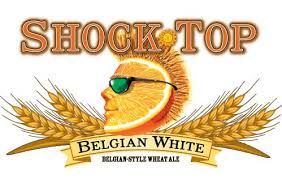A few months back, as I was walking around the neighborhood, I passed by
Coit Liquor, a venerable (1961) North Beach institution that has a pretty good selection of craft and foreign beers. In the window was a big, glossy display, with posters and banners, for a beer I'd never heard of, "Shock Top Belgian White." It had a mascot, an orange slice sporting a face, sunglasses, and a mohawk of grain stalks.
 |
| Behold, the banal face of evil. |
Now, it's one thing to come across a beer you've never seen before. That happens all the time, even at your local supermarket, if you're lucky enough to have a good buyer or a liberal-minded distributor, at least in parts of the country where distributors have access to a range of craft beers.
But when you go by your local bottle shop, and there's not just a new beer, but a new beer with copious marketing materials featuring a cheezy mascot, well, there's something skunky in Denmark.
Similarly, a few years ago, I happened to be in Las Vegas for some work function, and I went down to the bar, looking for a beer. All they had was Big Yellow, in its various incarnations ("lite," "dry," whatever), and something called "Blue Moon Belgian White," which I didn't recognize, and sounded like the closest thing to a craft beer I was going to get. So I ordered it. They served it in a logo glass, with a slice of orange. It was pale. It was bland.
It was Coors.
Shock Top is Bud.
Welcome to the world of fake microbrews.
The fact is that, all the craft brew in America represents a mere
drop in the bucket - 6% of the volume and 9% of the dollar value. America's largest craft brewer, Sam Adams, sells 2.5 million barrels and has a revenue of $512 million. (Yeungling is roughly the same size; the two are essentially tied for the title of largest American brewer.) By contrast, Anheuser-Busch (AKA Bud), the formerly American company that's now owned by multinational AB InBev, sells 121 million barrels, has an annual revenue of over $15
billion, and controls 48% of US market share. The second largest brewer in America, MillerCoors (owned by multinationals SABMiller and Molson Coors), controls 30% of the US market.
Imported beer--most of it produced by companies owned by InBev (which owns Bass, Beck's, Boddington's, Corona, Franziskaner, Goose Island, Hoegaarden, Labatt, Leffe, Lowenbrau, Modello, Oranjeboom, Pacifico, Schooner, Spaten, St. Pauli Girl, Stella Artois, Whitbread, and many others), SABMiller (which owns Peroni, Pilsner Urquell, and many others), Heineken (which owns Moretti, Affligem, Amstel, Beamish, Murphy's, Dos Equis, Tecate, Sol, Bohemia, and many others), and Carlsberg (which owns Kronenbourg and many others)--constitutes the remainder of the US market. In fact, those 4 produce over half the world's beer.
But, you say, what about all of the other big ol' US brands?
Michelob, Rolling Rock, Natural Light?
Anheuser-Busch.
Hamm's, Milwaukee's Best, Icehouse, Killian's Irish Red, Keystone, Henry Weinhard?
MillerCoors.
Pabst? (Yes, I'm looking at you, you hipsters swilling your "ironic" PBRs...) Pabst hasn't actually brewed its own beer since 1996, when it contracted all its brewing, first to Stroh (which Pabst bough 3 years later), and then in 2001 to Miller. Today it's little more than a marketing and real estate company, holding the Schlitz, Old Milwaukee, Stroh's, Colt 45, St. Ides, Lone Star, Olympia, Rainier, Schaefer, and other brands.
Consolidation in the American brewing industry can be traced back to the 1950s, when TV advertising allowed for the creation of national identities for breweries. By the early 80s, the number of breweries in the US had fallen from 407 to 83, controlled by 44 companies, the top 6 of which (Anheuser-Busch, Miller, Heilman, Stroh, Coors, and Pabst) controlled 92% of US beer production. It didn't help, of course, that they were all producing more-or-less indistinguishable products on an industrial scale. Control over advertising and distribution channels was really the only determinant of success.
The influence of the Great Imperialist Brewing Satan warped the resurgence of regional microbreweries that began in the mid-80s. A prime example can be found in Portland's
Widmer Brothers (founded in 1984), the brewery that introduced hefeweizen to America; and Seattle's
Redhook (founded in 1981), with its signature ESB. To compete nationally, these two merged in 2007 to form the Craft Brew Alliance (which later bought
Kona Brewing); but because of the GIBS's stranglehold on distribution, they had to sell a third stake to AB InBev to get access.
And now, perhaps most insidious of all, aside from the microbreweries owned or part-owned by Big Yellow, are the fake micros like Blue Moon and Shock Top. The beer case in your local grocery or liquor store is already a battleground, where legitimate microbrewers must fight for shelf space against Bud, Bud Light, Miller, Miller Lite, Coors, Coors Light, in bottles, cans, six-packs, twelve packs, and suitcases; not to mention the "black crown," "chelada," "chill," "draft," "dry," "high life," "ice," "lime," "private reserve," "premium," "red," "select," and "wheat" permutations they can think of to force sellers to put on the shelves and try to convince you it's not Yellow. But now they have to compete for the tiny sliver of "microbrew" shelf space against the fake microbrews (or "nostalgia" brands), because the market is essentially saturated with a commodity product, and the macrobrewing dinosaurs are reduced to trying to stamp out the craft brewer mammals underfoot to try to squeeze out the last pips of profit, in the process crushing all innovation, diversity, and regional character.
Grrrrrr... </rant>
